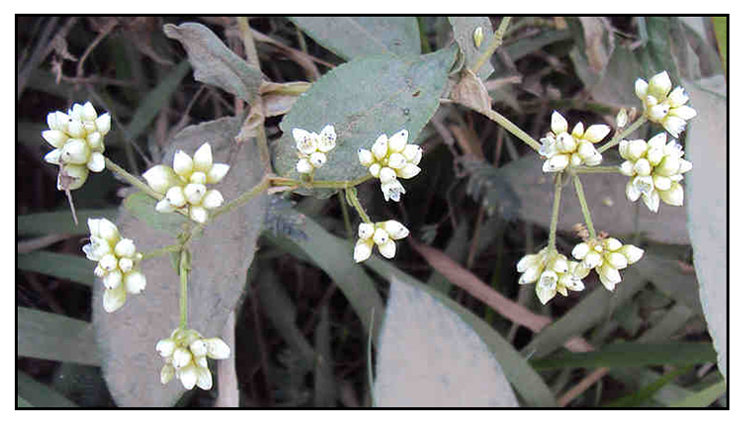
Family •Polygonaceae
Daynon
Persicaria chinensis (L.) H.Gtoss
CHINESE KNOTWEED
Huo
tan mu
| Scientific names | Common names |
| Ampelygonum chinense L. | Bota-bota (Ig.) |
| Persicaria chinensis (L.) H. Gross | Darnon (Ig.) |
| Polygonum chinense (L.) Lindl. | Daynon (Tag.) |
| Kulang-kulang (Neg.) | |
| Langingit (If.) | |
| Lutudan (Bon.) | |
| Vono (Iv.) | |
| Chinese knotweed (Engl.) | |
| Chinese smartweed (Engl.) | |
| Creeping smartweed *Emgl.( | |
| Common marsh buchwheat (Engl.) | |
| Knotgrass (Engl.) | |
| Red bush (Engl.) | |
| Persicaria chinensis (L.) H.Gross is an accepted name. KEW: Plants of the World Online | |
| Other vernacular names |
| CHINESE: Huo tan mu. |
| FRENCH: Liane rouge, Persicaire de China, Liane rouge. |
| JAPANESE: Tsuru soba. |
| KANNADA: Nir kanigalu. |
| MALAYALAM: Mudanthi, Mukkala, Oduthan, Poovallikodi, Thiruthanni, Thondi. |
| TAMIL: Actalaree, Sivappu kumbakodaali. |
| VIETNAMESE: La lan. |
|
Gen info Botany Distribution Parts
utilized: Constituents Properties Uses Studies Availability |
Updated May 2022 / March 2018
April 2015
![]()
 |
PHOTOS / ILLUSTRATIONS |
| IMAGE SOURCE: / File:Persicaria chinensis 15.JPG / Vinayaraj / Creative Commons Attribution-Share Alike 3.0 Unported license. / click on photo to see source image / Wikimedia Commons |
| Additional
Sources and Suggested Readings (1) EVALUATION OF ANTIBACTERIAL AND ANTIFUNGAL ACTIVITIES OF PERSICARIA CHINENSIS LEAVES / Mei Shu, Lai, D Sudhahar, K Anandarajagopal / IJPSR, 2012; Vol 3, No 8: 2825-2830 (2) AP-1-Targeting Anti-Inflammatory Activity of the Methanolic Extract of Persicaria chinensis / Muhammad Jahangir Hossen, Seung Cheol Kim, Young-Jin Son, Kwang-Soo Baek, Eunji Kim, Woo Seok Yang, Deok Jeong, Jae Gwang Park, Han Gyung Kim, Woo-Jae Chung, Keejung Yoon, Chongsuk Ryou, Sang Yeol Lee, Jong-Hoon Kim, and Jae Youl Cho / Evidence-Based Complementary and Alternative Medicine Volume 2015 (2015) / http://dx.doi.org/10.1155/2015/608126 (3) In vivo and in vitro anti-inflammatory activities of Persicaria chinensis methanolic extract targeting Src/Syk/NF-κB. / Muhammad Jahangir Hossen, Kwang-Soo Baek, Eunji Kim, Woo Seok Yang, Deok Jeong, Jun Ho Kim, Dae-Hyuk Kweon, Deok Hyo Yoon, Tae Woong Kim, Jong-Hoon Kim, Jae Youl Cho / J Ethnopharmacol 2015 Jan 8;159:9-16. (4) Medicinal plants used by the Tamang community in the Makawanpur district of central Nepal / Dol Raj Luitel*, Maan B Rokaya*, Binu Timsina and Zuzana Münzbergová / Journal of Ethnobiology and Ethnomedicine 2014, 10:5 / http://www.ethnobiomed.com/content/10/1/5 (5) Persicaria chinensis var. chinesis —CYTOTOXIC ACTIVITY / studentsrepo.um.edu.my/3939/4/ (6) A bioactivity-guided study on the anti-diarrheal activity of Polygonum chinense Linn. / Xiao HT, Tsang SW, Qin HY, Choi FF, Yang ZJ, Han QB, Chen HB, Xu HX, Shen H, Lu AP, Bian ZX. / J Ethnopharmacol. 2013 Sep 16;149(2):499-505 / doi: 10.1016/j.jep.2013.07.007. Epub 2013 Jul 26. (7) Gastroprotective Activity of Polygonum chinense Aqueous Leaf Extract on Ethanol-Induced Hemorrhagic Mucosal Lesions in Rats / Iza Farhana Ismail, Shahram Golbabapour, Pouya Hassandarvish, Maryam Hajrezaie, Nazia Abdul Majid, Farkaad A. Kadir, Fouad Al-Bayaty, Khalijah Awang, Hazrina Hazni and Mahmood Ameen Abdulla / Evidence-Based Complementary and Alternative Medicine, Volume 2012 (2012) / http://dx.doi.org/10.1155/2012/404012 (8) Cytotoxic, Antioxidant and Antimicrobial Activity of Polygonum Chinensis Linn / A.R. Srividya, A. Shalom, R. Chandrasekhar, P. Vijayan and V.J. Vishnuvarthtan / Int J Pharm Sci Nanotech Vol 4; Issue 4, January- March 2012 (9) IN VITRO ANTHELMINTIC POTENTIAL OF PERSICARIA CHINENSIS LEAVES / Shu Mei Lai*, D. Sudhahar, K. Anandarajagopal / International Journal of Biological & Pharmaceutical Research. 2012; 3(3): 400-404. (10) Study on the liver-protective effect of alcohol extracts from Polygonum chinense / GAO Ya,ZHU Hua / West China Journal of Pharmaceutical Sciences, 2012-03 (11) Studies on Chemical Constituents of Polygonum Chinensis L. and Polygonum Amplexicaule Var. Sinense and Quality Control of Polygonum Chinensis L. / China Papers , May 25, 2010 (12) Persicaria chinensis: Common names / EOL (13) Characterization and mechanisms of anti-influenza virus metabolites isolated from the Vietnamese medicinal plant Polygonum chinense / Thu Thi Tran, Meehyein Kim, Jin-Cheol Kim / BMC Complementary and Alternative Medicine, 2017; 17; Art no: 162 / DOI: 10.1186/s12906-17-1675-6 (14) Comparative Analysis of Bioactivities of Four Polygonum Species / Wu-Yang Huang, Yi-Zhong Cai, Jie Xing, Harold Corke, Mei Sun / Planta Med, 2008; 74(1): pp 43-49 / DOI: 10.1055/s-2007-993759 (15) GC-MS analysis of phytocomponents in the ethanol extract of Polygonum chinense L. / Bagavathi Perumal Ezhilan, Bamasamy Neelamegam / Pharmacognosy Research, Jan-Mar 2012; 4(1): pp 11-14 / DOI: 10.4103/0974-8490.91028 / PMID:22224055 (16) Phenolic Compounds from Polygonum chinense Induce Growth Inhibition and Apoptosis of Cervical Cancer SiHa Cells / Wei Chne, Xian-Min Shen, Li Ma, Guo Ping Pen et al / Biomed Research International, Vol 2020, Article ID 8868508 / DOI: 10.1155/2020/8868508 (17) Bioactive sesquiterpene, plasticizer, and phenols from the fungal endophytes of Polygonum chinense L. / Madhuchhanda Das, Harischandra Sripathy Prakash. Monnanda Somaiah Ma;ini / Annals of Microbiology, 68: pp 595-609 / DOI: 10.1007/s13213-018-1367-6 (18) Persicaria chinense / Plants of the World Online (19) Persicaria / Wikipedia |
• |
DOI: It is not uncommon for links on studies/sources to change. Copying and pasting the information on the search window or using the DOI (if available) will often redirect to the new link page. (Citing and Using a (DOI) Digital Object Identifier) |
| Â Â Â Â Â Â Â Â Â Â Â Â Â Â Â Â Â Â Â Â Â Â Â Â Â Â Â Â Â Â List of Understudied Philippine Medicinal Plants |
• |
 |
• |


